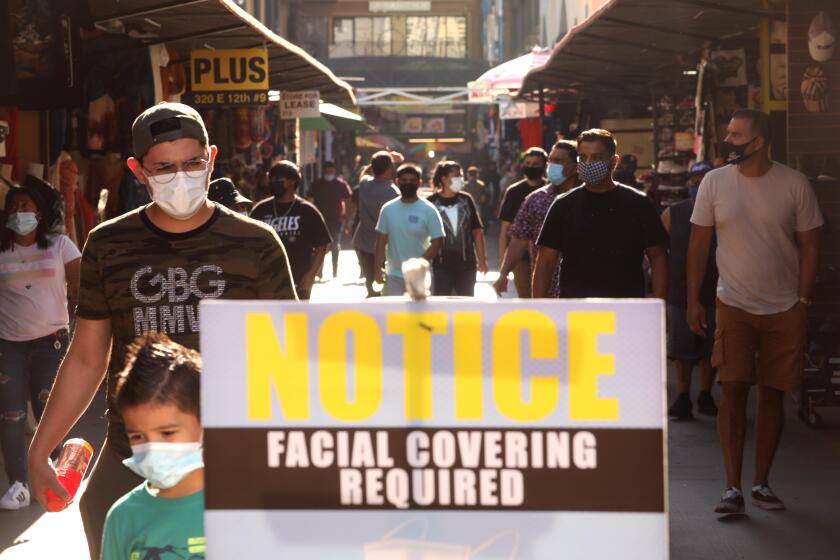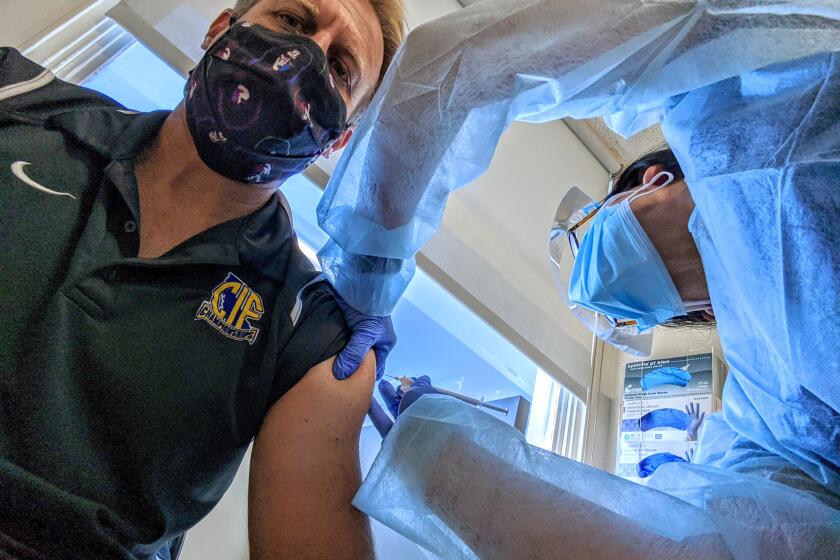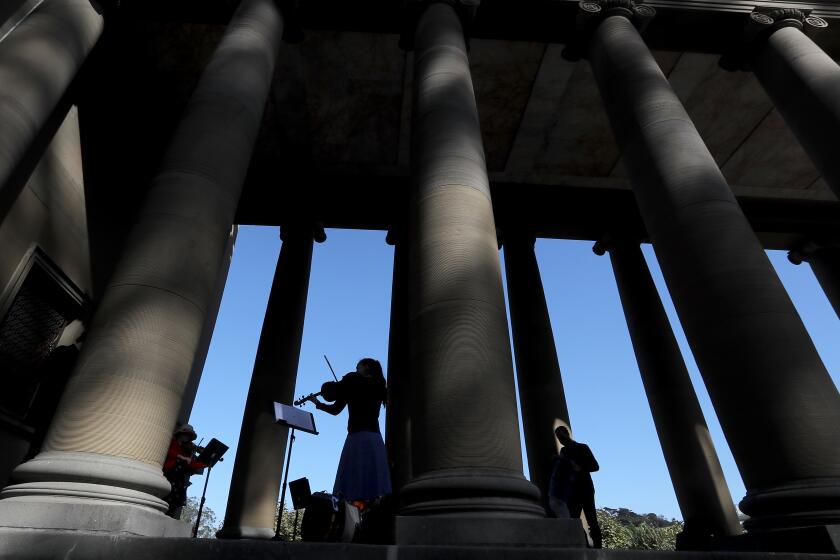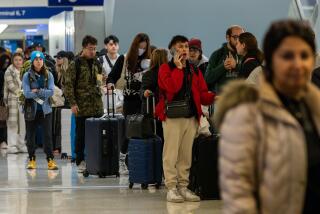As California nears 1 million coronavirus cases, Thanksgiving threatens new super-spreading danger
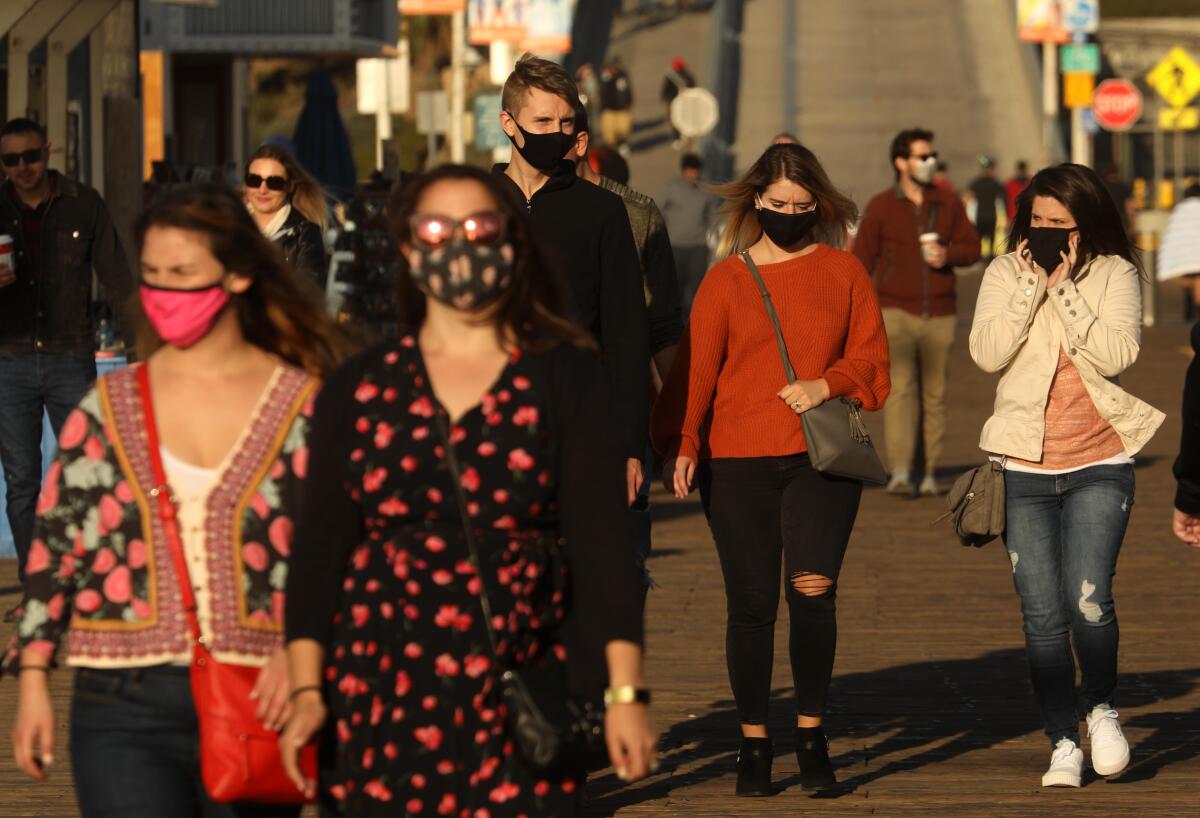
- Share via
California is approaching 1 million coronavirus cases at a crucial moment in the pandemic.
After months of declining infections amid stricter reopening rules, the virus is again spreading, with Los Angeles County and Silicon Valley seeing new surges that are sparking alarm among health officials.
The concerns are heightened by the upcoming Thanksgiving holiday. After months of restrictions, officials fear many people will make exceptions, attending gatherings that will further increase infections as California begins the holiday season.
China showed just how destructive and deadly large family meals can be in a pandemic, when celebrations for the Lunar New Year — that country’s version of Thanksgiving and Christmas — and related cross-country travel ended up seeding the highly contagious virus worldwide, fueling the worst global pandemic in more than a century.
The most recent spike has been attributed in part to social gatherings — including victory celebrations related to the Lakers and Dodgers. There are also concerns that the virus might have been spread more through celebrations over Joe Biden’s presidential win.
But Thanksgiving brings a new level of peril.
State health officials have released new guidelines for socializing that prohibit gatherings among more than three households.
The best way to ensure that family and friends stay safe is to limit celebrations to members of your household only, experts say. And that goes for Christmas and other winter holidays too.
“Stop. Don’t do either. Really,” said Dr. George Rutherford, an epidemiologist and infectious diseases expert at UC San Francisco. That includes saying no to flying home for the holidays, Rutherford said. “The basic advice is: Stay within your pods. Stay within your bubbles. Stay within your household.”
“If you listen to the [U.S. Centers for Disease Control and Prevention], the main drivers nationwide — and I wouldn’t think that’s any different for California — are small gatherings,” Rutherford said. “That’s something that I think people are really quite concerned about in my world, especially if we’re starting to surge right now.”
California is entering another coronavirus wave, as much of the rest of the country has done. Health officials in Los Angeles County and Santa Clara County, Northern California’s most populous, said Monday it’s now clear they’ve entered a new surge, something that cannot be explained away by data reporting delays or a random bad couple of days.
While California has started to see a rise in coronavirus cases, the pace of increase is slower than that seen in the rest of the United States.
On Monday night, California’s COVID-19 death tally surpassed 18,000, according to The Times’ California coronavirus tracker. That death toll is six times worse than the one estimated for the great 1906 earthquake that destroyed much of San Francisco. More than 982,000 coronavirus infections have been diagnosed in California.
Halloween parties may already be to blame for some of the spike in coronavirus infections. Weekly cases in California have nearly doubled over the past month; four weeks ago, more than 20,000 cases were reported in a week statewide, but in the last week, nearly 40,000 cases were reported for the seven-day period that ended Sunday, according to a Times analysis.
Still, California remains in better shape than other parts of the nation, a likely result of better-than-average mask use and the state’s slower reopening of the economy. The Golden State has the 38th highest per capita cumulative coronavirus case rate among the 50 states, the District of Columbia and Puerto Rico, with about 2,500 cases per 100,000 residents. By contrast, Wisconsin and Iowa have roughly double California’s case rate, and North Dakota has triple.
But a version of the nightmare scenarios seen in Europe and the U.S. Midwest, where hospitals are overwhelmed, could easily happen in California if the state’s residents collectively shrug at the pandemic and dive into large communal Thanksgiving feasts, with family and friends flying from around the country and spending half a day together indoors, giving hugs and taking off their masks.
Nationwide, 238,000 people in the U.S. have died from COVID-19, and more than 134,000 additional deaths are currently forecast to occur through the end of President Trump’s term on Jan. 20, including about 10,000 in California, according to the University of Washington’s Institute for Health Metrics and Evaluation.
Harder-hit places “serve as a reminder that that can easily be our reality as well,” said Barbara Ferrer, the L.A. County director of public health. “When cases surged in New York City, and we all said, ‘Oh, you know, that’s not going to happen here.’ And then in July, we had an equally troubling surge in cases. It did happen here.”
Father and daughter partook in a vaccine trial at Kaiser hospital. On Monday, Pfizer announced its success
The surge is being seen across California, according to The Times’ analysis. In the five-county Southern California region of L.A., Orange, Riverside, San Bernardino and Ventura counties, weekly cases have doubled — from about 11,000 cases four weeks ago to about 22,000 in the last week. Weekly cases are up 70% in San Diego County, from about 1,800 to 3,100, over the same period.
Weekly cases are up 74% in the San Joaquin Valley; up 82% in the San Francisco Bay Area; and up 143% in the Sacramento area.
The weekly rate at which California’s coronavirus test results are turning up positive has also dramatically increased in recent weeks, from 2.4% in mid-October to 4.1% for the most recent seven-day period.
Starting in late July, California had recorded 12 consecutive weeks of declining hospitalizations related to coronavirus infections. But that began to change last month, and in the last week, there were nearly 2,800 people on average hospitalized every day with COVID-19 infections, a 24% increase from four weeks ago.
Last week, the deaths of 308 Californians from COVID-19 were reported, the lowest number since March. But an increase in cases and hospitalizations will eventually lead to more deaths.
In Santa Clara County, the home to Silicon Valley, officials had been monitoring a slow increase in cases throughout October. Last week, there was a steep rise.
“It concerns all of us because it could mean that we’re in for a large surge that will be difficult to control,” said Dr. Sara Cody, the Santa Clara County health officer who was one of the chief architects of the nation’s first regional stay-at-home order. “When we see a surge in cases, it is almost always followed by a surge in hospitalizations.”
Unlike Los Angeles, Riverside and San Bernardino counties, most Bay Area counties have enjoyed improved pandemic conditions and have advanced to less restrictive tiers in the state’s reopening framework. Reopenings of businesses such as indoor gyms and indoor dining at restaurants may have to be reversed if case rates worsen.
San Francisco shut down early in the pandemic and later limited reopening. Now the city is the first urban center in California where the risk of infection is rated as minimal.
“What we’re probably seeing with these increased numbers is people just letting their guard down,” Santa Clara County Supervisor Cindy Chavez said. She said she’s noticed that people are willing to keep their distance from strangers, but when seeing an old friend or family member, they embrace.
“This is a virus where 40% of people with infection have no symptoms,” Cody said, yet are infectious and can transmit the potentially deadly virus to others.
State officials have offered advice on how to have gatherings of multiple households more safely: Keep them outdoors, limit them to no more than three households and no more than two hours, stay six feet away from people you don’t live with, wear masks when not eating or drinking, and serve food in single-serve disposable containers.
And while experts were hopeful about the statement issued Monday that a COVID-19 vaccine candidate by the U.S. pharmaceutical company Pfizer was 90% effective, Gov. Gavin Newsom warned this is no time to suddenly think it is OK to resume meeting with friends for indoor dinners, as a friend of his thought it might.
“I had to immediately text back, saying ... this vaccine is not going to be readily available for mass distribution — not just Pfizer, but others — likely well into the next year,” Newsom said. “Wear a mask. Continue to physically distance, socially distance. Do not take your guard down.”
Health officers from the Bay Area released a joint statement Monday urging residents to avoid all nonessential travel and warned that traveling outside the region will “increase your chance of getting infected and spreading the virus to others after your return.”
Both the Bay Area health officers and the L.A. County Department of Public Health urge residents to quarantine for 14 days once they return from travel.
The virus continues to spread most among the youngest adults; in Silicon Valley, the uptick is largely in adults ages 18 to 34.
The virus also continues to spread faster in certain communities; in Santa Clara County, it’s in the heavily Latino neighborhoods of East San Jose and Gilroy.
In Los Angeles, the eastern San Fernando Valley neighborhoods of Pacoima and Sun Valley have double the adjusted coronavirus case rate of the county’s, with the communities reporting rates of 506 cases per 100,000 residents and 456 cases per 100,000 residents, respectively, over the last two weeks; the countywide rate is 188 cases per 100,000 residents.
More than a dozen other communities are also of particular concern because of increasing rates of cases: Palmdale, Lancaster, East Los Angeles, Van Nuys, El Monte, Downey, Pomona, North Hollywood, Glendale, Santa Clarita, South Gate, Florence-Firestone, Canoga Park and Panorama City.
That said, experts say, the virus won’t just stay in certain pockets. “This virus is going to spread. That’s what this virus does. And so it’s not just about the communities that are seeing higher case rates,” Cody said.
There are other possible reasons for the increase in coronavirus cases statewide. Rutherford said in Sonoma County, an increase in cases has been partly a result of people who had been isolating with COVID-19 being forced to flee because of the devastating wildfires this year. Statewide, the virus is also disproportionately spreading through Latino communities, in both agricultural and urban settings.
Cody said she understands the pandemic fatigue, and said there will be an end to the pandemic, someday.
“It takes an extraordinary amount of effort to keep it up, and people are tired. We’re here today to say we hear you ... and you still have to keep it up,” Cody said. “There is an end in sight. It’s just not next month or the month after that. So please, please: Keep wearing your face covering; keep staying at home to the greatest extent that you can; keep your activities outdoors; and keep your distance.”
More to Read
Sign up for Essential California
The most important California stories and recommendations in your inbox every morning.
You may occasionally receive promotional content from the Los Angeles Times.

